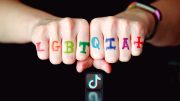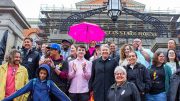Next week (9/27) is National Gay Men’s HIV Awareness Day
Today, as was the case 30 years ago, gay and bisexual men are among those most vulnerable to HIV infection. The U.S. Centers for Disease Control and Prevention (CDC) estimates that gay and bisexual men are at least 44 times more vulnerable to HIV infection than the general population.
As we mark National Gay Men’s HIV Awareness Day on Sept. 27, what can we—and what should we—be doing to reduce this risk?
One surprising answer: Enact and implement LGBT rights legislation such as the Employment Non-Discrimination Act (ENDA), and expand legal recognition of the marriages of same-sex couples.
In states with populations that are openly hostile to LGBT people and express that hostility by enacting bans against the rights of same-sex couples to marry, we see statistically significant increases in HIV diagnoses among gay and bisexual men. In 2009 two economists at Emory University looked at data on the attitudes of Americans toward LGBT people from the 1970s through 2008. Here’s what they found: States with laws against the marriage rights of same-sex couples saw an increase in HIV diagnoses by 4 per 100,000 people. [pullquote]In states with populations that are openly hostile to LGBT people and express that hostility by enacting bans against the rights of same-sex couples to marry, we see statistically significant increases in HIV diagnoses among gay and bisexual men.[/pullquote]
IN OTHER WORDS, bigotry makes us sick.
So what does full acceptance do?
It improves our health.
A 2012 study published in the American Journal of Public Health looked at the impact of marriage equality in Massachusetts on gay and bisexual men living in that state and found that the mere act of legally recognizing the marriages of same-sex couples improved the health of gay and bisexual men. In the year after the marriages of same-sex couples were legally recognized in Massachusetts, there was a 13-percent drop in overall medical visits among gay and bisexual men, and a 10-percent drop in overall health care costs for gay and bisexual men.
None of this is necessarily surprising. We should expect negative health outcomes when a community is driven underground by threats to their jobs for their sexual orientation, when laws are passed that make members of a community second-class citizens, and when the community is subjected to ridicule, physical attacks, and shame. This is why the LGBT community has a significantly higher rate of teen suicide, drug and alcohol abuse, STIs, and other behavioral diseases. And it’s why the CDC finds, in its most recent report on HIV infection rates, that there is a “troubling and continuing increase in new infections among young gay and bisexual men.” [pullquote]This is why the LGBT community has a significantly higher rate of teen suicide, drug and alcohol abuse, STIs, and other behavioral diseases.[/pullquote]
The end of the AIDS epidemic will not happen without more funding for medical research, access to care for everyone (including LGBT people who are undocumented), and support for community-based services and interventions for those on the margins and in crisis.
But ending AIDS is also going to take more work from the LGBT community. We need to be talking about HIV and taking steps to reduce stigma. You can act by demanding that LGBT advocacy organizations add HIV to their priorities. You can also take National Gay Men’s HIV Awareness Day as an opportunity to get yourself, your spouse, or your partner tested for HIV. Take a friend to be tested. Stay with him or her for the results, showing them that you care. You might save a life, and you will help end an epidemic.
*Rebecca Haag is the President & CEO of AIDS Action Committee.








